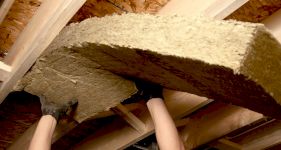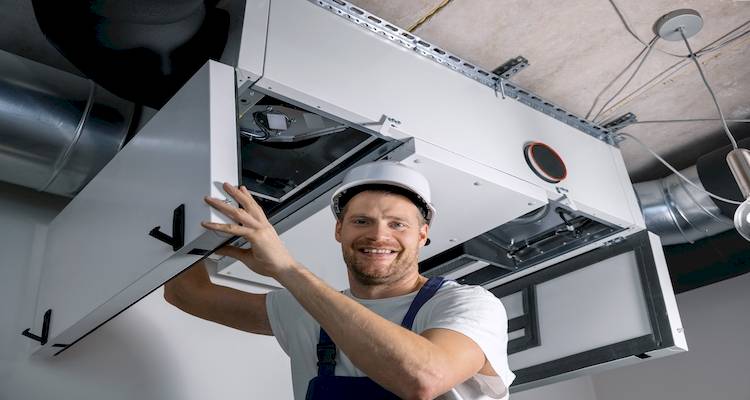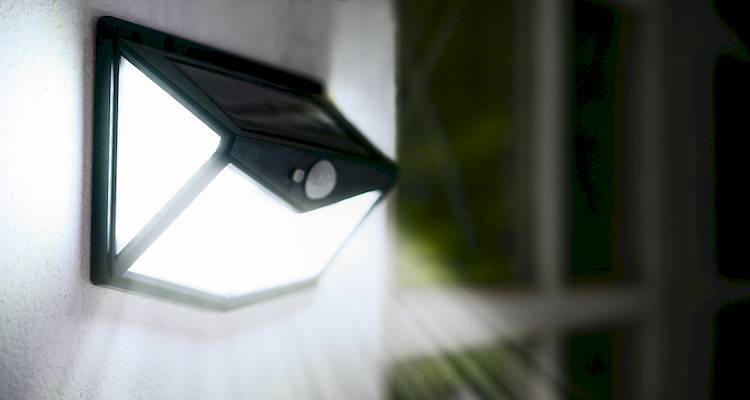Conservatory Cost
- The average uPVC conservatory extension costs £15,000 in the UK.
- It takes approximately 3 to 6 weeks to complete the build.
- Although for a fully fitted conservatory, allow an additional 6 weeks.
- NEW! Our conservatory cost calculator, which gives you an estimate of the cost of a conservatory in your circumstances.
- A breakdown of what you need to budget for different sized installations, including how much a 6m x 3m and 4m x 3m conservatory cost in 2025.
- How long it takes to get a new conservatory fitted and an overview of what's involved.
- How to find and hire a conservatory builder near you.
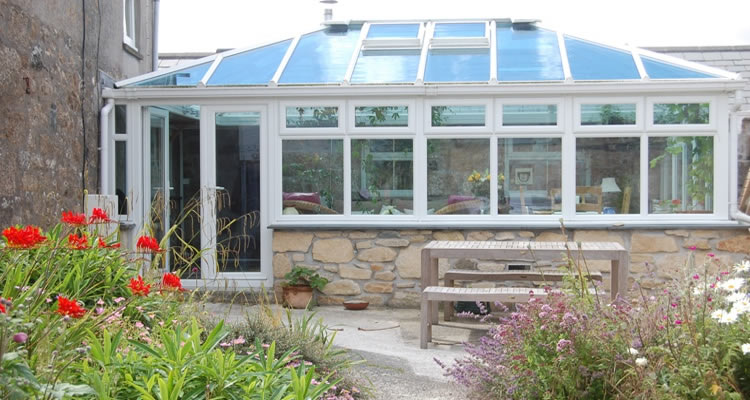
£15,000
Table of Contents
- How Much to Build a Conservatory?
- Labour Cost of Conservatory Extension
- Factors That Impact Conservatory Costs
- What's Involved in Building a New Conservatory?
- Types of Conservatories
- Can I Install a Conservatory Myself?
- Kitchen Conservatory Cost
- Bespoke Conservatory Extensions
- Planning Permission for a Conservatory Extension
- Building Regulations for a Conservatory Extension
- How to Keep Conservatory Costs Down
- Checklist: Hiring a Conservatory Installer
New Conservatory Cost Calculator
How Much to Build a Conservatory?
In 2025, the average conservatory cost for a standard uPVC conservatory is around £15,000, although this doesn't include fixtures and fittings. However, should you choose a more premium material, such as timber, then expect initial costs to be much higher.
Other factors can also impact the cost of a conservatory such as the size and location, the overall design and any extra features you may choose, along with foundation work and eventually adding those finishing touches.
The following guide includes conservatory prices per square metre for a range of options: including traditional lean to conservatories and Victorian conservatories, as well as Edwardian, P-shaped, T-shaped, L-shaped and orangeries.
Ready to get a quote for a new conservatory price?
MyJobQuote has a range of builders that specialise in building conservatory extension, who are ready to provide you with a free, no obligation quote!
Looking to find out how much a conservatory costs in the UK?
While it's possible to build a conservatory on a budget, it can also be a project based on creating an area of luxury – however, as a basic guide, here are the average starting prices for different conservatory designs:
| Design type | Minimum price |
|---|---|
| Lean-to | £7,500 |
| Victorian / Edwardian / Georgian / Elizabethan / Regency | £8,500 |
| Loggia / T-shape / P-shape / B-shape / U-shape | £15,000 |
Let's take a closer look at the cost per m² for those different types of conservatories (structural costs only, excluding any foundation and groundwork preparation):
| Type of Conservatory | Material | Cost per m² |
|---|---|---|
| Lean-to Conservatory | Polycarbonate with dwarf wall | £1,000 per m² |
| Lean-to Conservatory | Glass fully glazed | £970 per m² |
| Edwardian Conservatory | Polycarbonate with dwarf wall | £875 per m² |
| Edwardian Conservatory | Glass fully glazed | £812 per m² |
| P-Shaped Conservatory | Polycarbonate | £875 per m² |
| P-Shaped Conservatory | Glass fully glazed | £837 per m² |
| Victorian Conservatory | Glass with dwarf wall | £400 per m² |
I have an old conservatory on a 3.2m x 2.8m base, but I need a new one at 3.2m x 3.5m. It will be built on a typical 600mm brick wall, with one corner section bricked up (no windows) to accommodate a toilet. Any idea of the installation costs?
Fully Fitted Conservatory Prices
To put the conservatory costs per m² into context, the below prices are based on a fully-fitted lean-to conservatory between 7m² to 10m²:
| Lean-to Design | Estimated Cost |
|---|---|
| Polycarbonate w/dwarf wall | £7,500 – £9,500 |
| Glass w/dwarf wall | £8,000 – £10,000 |
| Polycarbonate fully glazed | £6,500 – £8,000 |
| Glass fully glazed | £7,000 – £8,500 |
The most expensive type of lean-to in our range is a large 10m² glass with dwarf wall conservatory, priced at £10,000. Dwarf walls give your conservatory greater insulation and privacy, offering the construction a "sturdier" feel - but it does come at a higher cost.
Let's now consider conservatory prices for an Edwardian design, based around 12m² to 16m² in size:
| Edwardian Design | Estimated Cost |
|---|---|
| Polycarbonate w/dwarf wall | £9,500 – £14,250 |
| Glass w/dwarf wall | £10,000 – £15,250 |
| Polycarbonate fully glazed | £8,250 – £12,250 |
| Glass fully glazed | £8,750 – £13,250 |
A small 12m² Edwardian-styled conservatory costs between £8,250 to £10,000 depending on it being fully glazed or built using polycarbonate.
Lastly, we take a look at P-shaped conservatory extensions costs in the table below, these prices are based on a 15m² to 20m² build:
| P-Shape Design | Estimated Cost |
|---|---|
| Polycarbonate | £13,250 – £16,500 |
| Glass | £13,375 – £15,750 |
To put this into context, the average cost of a lean-to conservatory (the lowest-cost design) is around £8,250. This will increase or decrease depending on the size of the conservatory, whether you want polycarbonate or glass roofing, and whether you want the sides fully glazed or with a dwarf wall.
At the other end of the scale, a P-shaped conservatory will cost on average £14,500, with the same variations of price dependent on specifications.
Supply Cost of Conservatory Extension
The supply cost will vary depending on size and individual specification. However, the below are some material-only estimates to provide you with a rough guide as a starting point. Please note these are based on an area of around 6m² to 18m², for a bespoke conservatory, with custom frames, glass, fittings etc, you would have to contact a distributor directly to request a quote.
| Type | Estimated Cost |
|---|---|
| Lean-to fully glazed | £3,400 – £4,600 |
| Edwardian with dwarf wall | £2,900 – £5,300 |
| Victorian with dwarf wall | £2,400 – £5,200 |
Labour Cost of Conservatory Extension
Take a look at this cost graphic to determine the construction cost of your conservatory and approximately how long it will take:

The above costs are based on an average size build for each type of conservatory, although end prices can vary depending on the size and design of your build.
Likewise, the cost of individual tradesmen can vary between builds and you are likely to pay depending on experience and qualifications. Additional factors also need to be considered, such as how much time will each specialist spend onsite and also the location of your property - as labour fees tend to be higher in London and the South East.
If you're hiring a company to oversee your conservatory extension, then you will most likely have a designated project manager. They will help arrange individual members of the team, which should then be broken down as part of your quote. However, as a general guide we have outlined the cost for each tradesmen as per below:
| Tradesmen | Cost per Day |
|---|---|
| Labourer | £50 to £60 |
| General Builder | £100 to £150 |
| Window Installer | £125 to £150 |
| Plasterer | £140 to £160 |
| Painter and Decorator | £150 to £200 |
| Electrician | £125 to £200 |
| Bricklayer | £180 to £250 |
How long might it take to have a 20 to 25 square metre conservatory constructed?
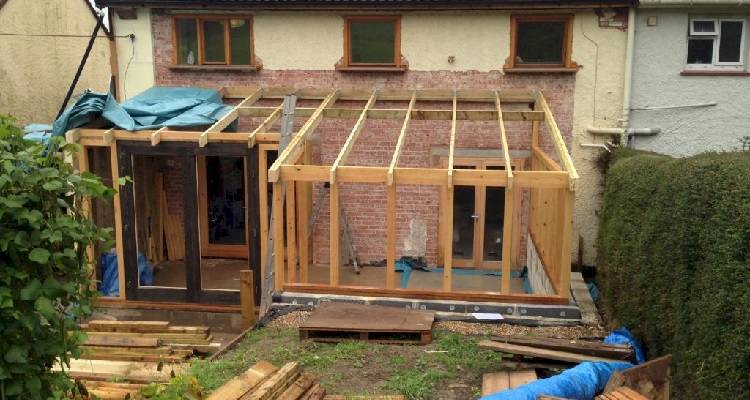
Factors That Impact Conservatory Costs
Groundwork and Building the Frame
Choosing the right base for your framework is crucial for the longevity of your conservatory, so a site survey is recommended. The ground will need excavation to determine foundation depth, after which you can choose a flat or raised base. Foundations may be pile, raft, or standard, depending on local conditions.
Once the base is ready, the frame can be added. Most conservatory frames are uPVC, wood, or aluminium. uPVC is cost-effective, low-maintenance, and comes in various designs. Hardwood frames are pricier but offer a cosy, rustic feel, while aluminium allows thinner frames and larger windows, making it the most expensive option.
Are my foundations deep enough for a conservatory?
Types of Conservatory Glass
The type of glazing affects overall cost, with the main choices being glass or polycarbonate. Glass is more durable and retains heat well, making it the more energy-efficient option. Polycarbonate costs less to install, provides built-in UV protection, and is easier to work with due to its flexibility and lightweight nature.
Also consider uPVC windows costs as double glazing can help reduce heat loss and provide improved insulation, creating a more energy-efficient option.
Here are some additional glazing options:
- Toughened safety glass — durable and safe for homes with children.
- Laminated glass — secure and safe, with a plastic layer that contributes to extra insulation.
- Heat reflective glass — keeps your home cooler in summer while still allowing natural light.
- Self-cleaning glass — uses sunlight to break down dirt and rain to wash it away.
- Solar-controlled glass — has a light tint or metallic coating that reduces heat from the sun.
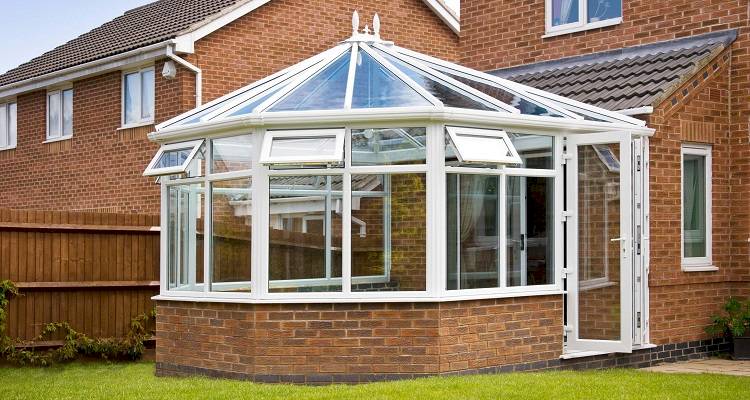
Dwarf Wall
A dwarf wall links the conservatory to your existing property and compared to fully glazed walls, can moderate temperature, reducing the need for heating or ventilation. There's also less cleaning involved, as there isn't any glass installed at a lower level, although this can also restrict your view of the outdoors.
Roofing Style
The type of roof will impact the price, with the cost varying between styles. Lean-to conservatories normally have a flat roof, whereas most other designs are gable fronted or hip styled, although other variations are also available. If you're upgrading an existing roof, then conservatory roof replacement costs are also likely to increase should any additional structural work is required.
Is it possible to put a tiled or solid roof on my uPVC conservatory?
Conservatory Flooring
Vinyl flooring costs around £300 and is easy to clean. The cost of laying carpet is cheaper (£400) but potentially less durable, while solid oak flooring offers a luxurious feel at a higher cost (£1,300).
What's the best type of flooring for a conservatory?
Conservatory Insulation
Premium options include lightweight metal roofs with insulation layers, whereas budget alternatives can involve installing a secondary glazing layer. Tiling a conservatory roof can also help, while allowing you to include glazed panels to let in natural light.
Other less-expensive alternatives include reflective laminate or attaching heavy fabrics and curtains, although if you're cutting on costs, be mindful of potential condensation and damp.
How do I maximise security for a conservatory?
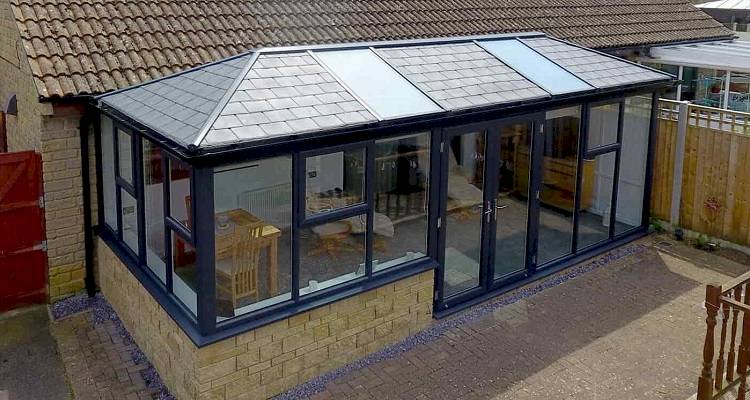
What's Involved in Building a New Conservatory?
Building a conservatory extension is a big project that requires a lot of patience and the right experience.
That's why we'd recommend hiring tradesmen who are already professionals in this type of building work. It's also best practice to request three quotes from separate companies used to building conservatories, which you can do so via MyJobQuote without any obligation to go ahead.
Below we take a look at the basic steps required in order to build a conservatory extension, although in reality, the process is much more complicated:
Before the Job Starts
- Preparing the Foundation — Lay a solid foundation using either foundation blocks or concrete. Cover it with a weed-suppressing membrane to maintain a neat finish and prevent plant damage.
During the Job
- Installing the Base — Place base sections into position, bolt them together, and attach them to the house. Insert floor insulation sheets and install the fixed floor on top.
- Attaching the Walls and Frames — Bolt the walls into position, fix them to the base, then fix the frames together and attach them to your house wall. Attach a skirt to the base, adding extra support if the ground slopes.
- Assembling the Roof — Assemble the roof and fix it in place.
- Installing Glass and Features — Install the glass panels, decorative cresting/finials, gutters, and downpipes. Add any internal trims to complete the conservatory.
After the Job
- Final Checks — Ensure all parts are secure, aligned, and fully watertight. Confirm that all finishes and trims are correctly fitted.
What makes a conservatory secure? A conservatory brochure says one is secure thanks to "11-point locking system and gearbox technology". What's gearbox technology, and how does it make a conservatory secure?
Types of Conservatories
A conservatory is defined as “a room with glass walls and a glass roof, usually connected to a house, used for growing plants or for relaxing in.” They were originally created in the 1500s so wealthy individuals could grow citrus fruits brought over by traders from the Mediterranean.
From there, they were used as standalone teahouses, and nowadays, they are attached to properties and often referred to as sunrooms or solariums. They come in various standard shapes/styles as below:
Lean-to
A cheap conservatory option, a lean-to conservatory is very simple and subtle. This style of conservatory is usually square or rectangular, and the longest side runs along an existing wall of your house. The roof attaches to the existing property wall, angling down to meet the front of the conservatory.
Edwardian
This type of conservatory has flat walls and is a very simple and symmetrical design, often square or rectangular. One of the benefits of an Edwardian-style conservatory is that it makes full use of the available floor space. You can have any size, as it has a pitched roof rather than one limited by the projection from the house.
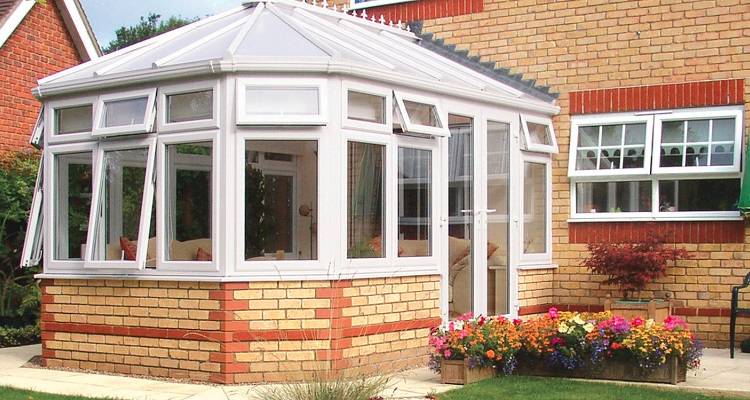
Victorian
A Victorian conservatory has a steeply pitched roof, often with highly decorative finials at the peak of the roof and crestings along the ridge. This was the style at the time, and so this type of conservatory better suits a traditional style home.
Gable
This is an elegant and bold style of conservatory. It has a vertical roof at the front, with the ridge running front to back and the sloping sides left and right. Its Georgian influence perfectly suits a period property.
P-Shape
This is a combination of a lean-to conservatory plus either an Edwardian or Victorian-style part at one end, forming the loop of the ‘P’. The P-shape conservatory effectively makes two separate rooms instead of one, and you can make each room as big or as small as you like.
T-Shape
The T-Shape conservatory works best on a larger property and has three sections, the central one of which projects out in front of the others. The T-shape conservatory can be built based on a Victorian, Gable or Edwardian style, with the central projection adding further space.
Lantern
This is more often used as a roof for an orangery (a more substantial building than a conservatory, with fully insulated brick walls and a glass roof) or a pool house, but can suit larger house conservatories. A lantern conservatory has a two-tiered ‘wedding cake’ roof, creating extra height, and the extra windows allow you to add more ventilation.
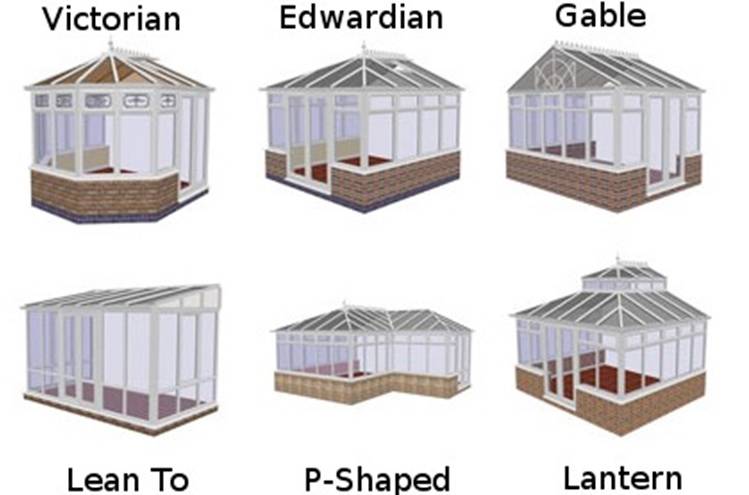
Can I Install a Conservatory Myself?
In theory, with the right experience, it is possible to install a conservatory extension yourself. Especially as some companies produce bespoke conservatory kits that come with full instructions designed with a DIY build in mind.
However, realistically building a conservatory is a complex task that often involves preparing groundwork and foundations, as well as drainage pipes and structural considerations that are far beyond the capabilities of most DIY projects.
If you are still considering going ahead and installing a conservatory extension yourself, then ensure you speak to a structural engineer for some professional advice before getting started.
How much would it cost to build a second-hand conservatory? My garden is paved and it would need a base to be built. It's around 3.5 metre by 2 metre, and is a lean-to conservatory.
Regarding the conservatory, a few problems with a used one could be the age of the glass (sealed units could start breaking down) and the frames could start discolouring. Nothing would be guaranteed as far as the frames and mechanisms go.
I would charge £1,200 for installation once the base has been done.
Kitchen Conservatory Cost
A kitchen conservatory can provide extra light and space if you're considering how to remodel your kitchen. This can make the area more inviting for social gatherings and improve its overall practicality.
A new kitchen can cost anywhere between £8,000 and £15,000. For an average-sized kitchen-friendly conservatory, expect to spend between £12,000 and £20,000 on the build itself. The overall price will also depend on factors such as ventilation, heating, lighting, flooring, units, and appliances.
During the design process, consider your outside view and required access to and from the property. Consult with an expert when it comes to planning any plumbing and electrics, prepare carefully to make the most of your new kitchen.
In general, a kitchen conservatory is cheaper to build than a single-story extension while still offering many of the advantages of a standard conservatory. However, it's worth recognising that a traditional bricks-and-mortar extension provides better insulation and often requires less maintenance, potentially making it a greater long-term investment.
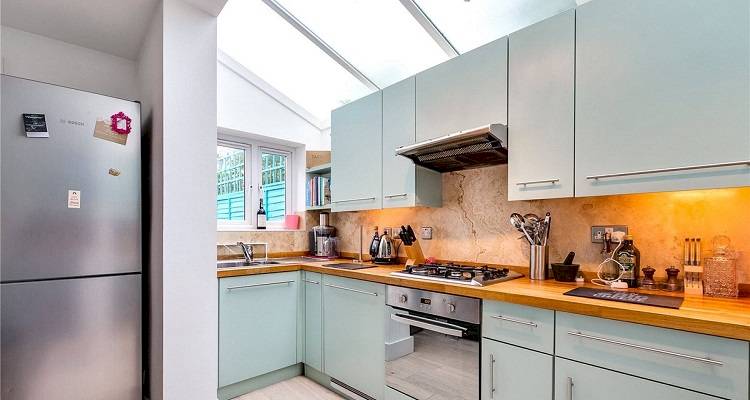
Bespoke Conservatory Extensions
It is very rare for people to design a conservatory from scratch and the prices for these would be on a personalised quote basis. However, many people take existing conservatory designs and personalise them to their own taste, space restrictions and requirements.
Most often, it is the P-, T- and L- shape conservatories which are personalised (the L-shape conservatory is wrapped around the corner of the building). In the case of these styles, you would alter the size of each part to fit your needs (e.g. a wide lean-to, with a small Edwardian at one end to make a P-shape conservatory).
Ahead of having a conservatory built in my garden, can an architect get planning permission approval?
There are a huge number of variations you can create with the differing conservatory styles, and configure each to match your property. As with any bespoke building, the cost of these would be individual. But if you want a very rough guide, you can research the costs for each and add them together.
The final result will likely be slightly over your final cost, as they will share one wall and because your builders will be available and onsite for both parts at the same time.
Planning Permission for a Conservatory Extension
As a general rule, conservatory extensions fall under Permitted Development rights and as such you may not need planning permission. However, if the conservatory covers more than 50% of the land around your home (or there has been any extension work carried out previously) then restrictions may apply.
If you live in a listed building or conservation area or any part of your conservatory is due to face a public road/walkway, then you will need to check with your local planning authority as planning permission may be required in these instances.
If you discover you need to apply for permission, the application fee is usually around £258, although this may vary between regions.
How large can a conservatory be before planning permission is necessary? Does it vary for height, length, or width, or is it based on area alone?
Building Regulations for a Conservatory Extension
If your conservatory is less than 30m² and remains separated from the main property by external-quality walls and doors, and has independent heating, it may be exempt from certain Building Regulations. However, any reputable builder should still follow structural guidelines to ensure the conservatory is safe and secure.
In the event you are removing external doors or walls as part of the build, or alter any drainage or electrical systems, those elements may still require Building Regulations approval.
Should you require any further advice, it's best to contact the building department within your local council.
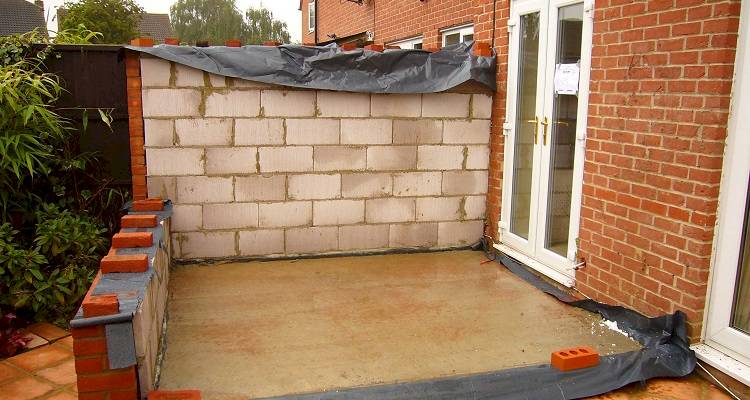
We have a conservatory with tiled floors and a polycarbonate roof. Can we convert that into an extension, that could also house a small wet room/toilet?
How to Keep Conservatory Costs Down
- Choose from one of the cheaper styles of conservatory – the more complex the design, the higher the cost, so simple is usually cheaper.
- Choose a smaller conservatory over a larger one – this is obvious, but the smaller the foundations, less glazing etc., as well as less heating, lighting etc., stands to make you a big saving.
- Choosing a new conservatory is most people’s choice, but a second-hand/used one can be a great bargain. So long as it has been taken apart carefully and is in great condition, you will only end up paying for your foundations and assembly.
- Instead of going to a conservatory specialist and paying to customise your new building, consider getting one ‘off the shelf’. Some larger DIY shops now sell complete conservatory packs, and where you’ll lose out on choice, you’ll make up for it in savings.
- Ensure you have a clear purpose for the new room(s) before you begin your search. You’ll need more sockets and lights for the kitchen (which will be used all day, every day). However, a crafting or reading room may only need a little heating and space for a comfy armchair.
- Do you need a large entry to your existing home? The smaller the area to knock through, the cheaper the final cost – so a large door will be considerably cheaper than opening up the full side of your house.
- Making sure you get quotes may give you the ability to negotiate, either on a price reduction or the inclusion of additional features. It's also worth considering that buying your conservatory in the down season (i.e., the colder months) will likely reduce the price.
- You can build the conservatory yourself, though this comes with its own pros, cons and costs. It’s a worthwhile consideration, though, if cost is your main sticking point.
- Try to do as much preparation as you can and ensure all the materials, contractors and waste disposal methods are ready and available before the project commences. This prevents short-notice hires (often more expensive) as well as extending the amount of time your labourers are on site.
Checklist: Hiring a Conservatory Installer
Consider the following key points before going ahead and hiring a conservatory installer:
- Do they have the relevant industry-related qualifications? Check whether they have the relevant industry-related qualifications or training, as well as the right hands-on experience to install a conservatory extension.
- Can they provide references from previous customers? Get references from previous customers and ask to see previous work, or if you've received a recommendation from someone you know, ask if you can take a look at the work they've had carried out to help you make an informed decision.
- Are they members of the Double Glazing and Conservatory Ombudsman Scheme? Membership provides extra protection, as companies are vetted on a continual basis to ensure professional standards.
- Have you requested multiple quotes? With the help of MyJobQuote find at least three companies who can provide a quote so you can compare pricing and ensures you’re paying a fair rate for the work.
- Have you received a written quote? This should be provided free of charge and clearly outline materials, labour, and any additional costs. It's also the best way to ensure you understand everything that is covered in the price.
- What are their warranty and guarantee policies? Confirm how long the warranty lasts, what it covers, and how claims are handled. You should also check with your own insurance company if you need any advice for once the extension is completed.
- Do they offer a deposit guarantee and insurance? This protects your money in case something goes wrong during the project and although liability insurance isn't a legal requirement, it covers in the event of injury or accidental damage.




